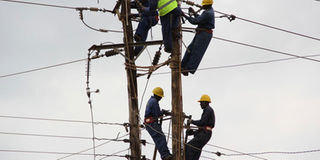Rural areas in dark with least power connections

PHOTO | JARED NYATYAYA | FILE Kenya Power employees replace an electricity pole in Eldoret. A survey seen by the Nation ranks North Eastern counties as the worst hit with few households having access to water, electricity, improved sanitation, housing and fuel.
What you need to know:
- The country also lacks access to safe latrines or toilets which has led to the pollution of rivers and the spread of diseases.
Access to toilets - Mandera County has the highest number—94 per cent of households that use traditional fuels while Nairobi—two per cent—has the lowest.
Electricity also remains a dream for many households with only 23 per cent of Kenyans having access.
Majority of the country’s population has no access to basic amenities, a new survey has shown.
The survey seen by the Nation ranks North Eastern counties as the worst hit with few households having access to water, electricity, improved sanitation, housing and fuel.
Even with the rural electrification program initiated by the Kibaki regime, majority of households in the rural areas still do not have access to power.
The country also lacks access to safe latrines or toilets which has led to the pollution of rivers and the spread of diseases.
Access to toilets
According to the survey, 39 per cent of Kenyans continue to use uncovered pit latrines, bucket latrines and bushes to pass stool.
Specifically, 17.5 per cent of Kenyans relieve themselves in bushes with Wajir been noted as the area with the highest number of people using unimproved sanitation.
This leaves 61 per cent of households as having access to improved waste disposal modes.
Such improved methods include connection to a main sewer, septic tanks and cesspits, ventilated improved pit latrines and covered pit latrines. The unimproved methods include uncovered pit latrines, bucket latrines, bushes among others.
Access to improved modes of waste disposal in Nairobi County is 15 times more than Wajir County.
FUEL USED
The survey also found out that majority of Kenyans—64 per cent—use primitive fuels in their households majority being in the rural setting.
Only 17 percent of households, mainly in the urban setting, use traditional fuels, mostly charcoal. Those who use the advanced fuels are only Six per cent, with the type of cooking fuel being related to the socio-economic status of households.
Mandera County has the highest number—94 per cent of households that use traditional fuels while Nairobi—two per cent—has the lowest.
Electricity also remains a dream for many households with only 23 per cent of Kenyans having access.
Out of this, only three counties have more than 50 per cent of their population connected. Nairobi leads with 72 per cent followed by Mombasa at 59 per cent while 54 per cent of Kiambu’s population has electricity.
Turkana is the worst hit with only two per cent of the population having access to electricity.
A household in Nairobi is 36 times more likely to have electricity for lighting than a household in Turkana and Tana River Counties.
The most commonly used form of lighting fuel in the country is tin lamps followed by lanterns at 30 percent.
The survey found out that the use of advanced fuels in Nairobi county is 56 times more than in Mandera county. It also found out that the use of transitional fuels in Mombasa County is 40 times more than in Wajir County while the use of primitive fuels in Wajir County is 47.5 times more than in Nairobi county.





